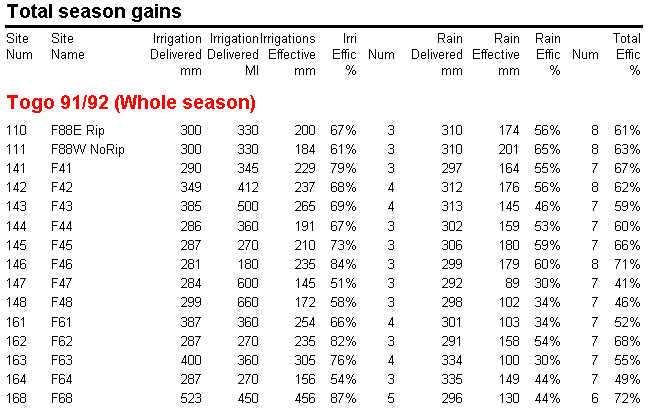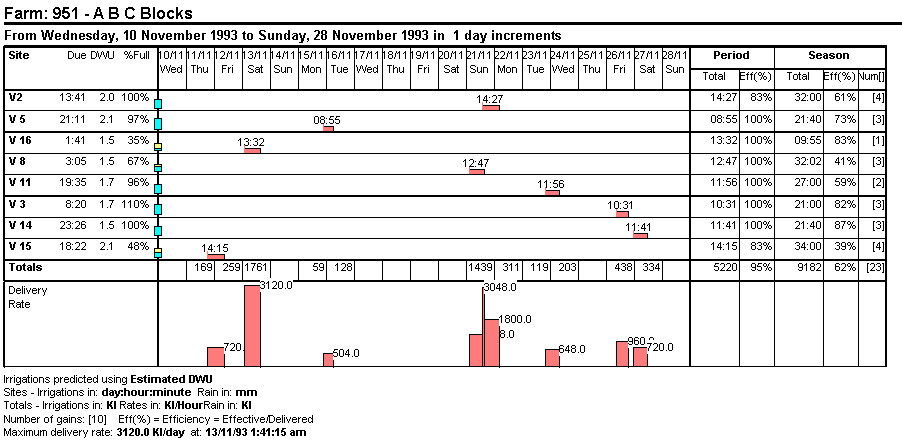
Summary
Introduction
Water Audit
Total Gains for each site
Site History - Irrigation by Irrigation
Site summary with yield efficiency
Benefits - Accurate Irrigation Scheduling
Irrigation Dates and Quantity for each
site
Effect on yield of too much water
Calibration of instruments
Conclusions
Australia is short of water, and has the major problem of salination. Irrigators will be asked for an annual water audit - how much water was delivered, how much of that was used by the crop and how much wasted.
The only way this can be done accurately is by measuring the volume of water delivered and the amount used by the crop. This will be a cost to the grower, but there are considerable benefits. Applying precise amounts of water, when required, can both save water and give increased yields and quality.
Australia is one of the driest continents, and the limited amount of available water is
in demand from urban areas and industry as well as agriculture. We also have the major
problem of salination. Irrigators are being asked to account for the water they use.
The wider community and the government are insisting, rightly, that water is used
efficiently and effectively, and is not wasted. A water audit is needed to account for
water use - every irrigator should be able to report how much water was delivered, how
much was used by the crop, and how much was wasted. The economic efficiency can then be
calculated - bales per Ml or cartons/Kl. This should become part of the routine accounting
system of the farm.
A water audit can only be done with careful and systematic measurement of...
A water audit is not just good management practice, providing justification and details of the use of a natural resource, but also provides considerable benefits By measuring soil moisture we will know exactly what is going on in the root zone, and can apply precise amounts of water when needed.
Soil moisture monitoring enables irrigations to accurately scheduled - precise amounts of water can be applied only when required - giving increases in yield and quality.
To quote a grower in the Western Cape, South Africa 'soil moisture monitoring has revolutionised the way we grow apples'.
Probe for Windows is a software programme that takes data from soil moisture sensors and calculates water use. It can output various reports that together constitute the basis of a water audit. The data in these examples is mainly from neutron probes, but could have been measured with other instruments such as the Diviner2000 and Delta-T Profile Probe.

The Gains Report, printed at the end of the season, shows the total amount of water delivered to each site, by rain or irrigation, together with the effective amount retained in the soil profile. The efficiency is effective/delivered amounts.
This data is from the 91/92 season at Togo Station, NSW, Australia.

The Site History Report shows each irrigation and rainfall in the season. In red is the amount delivered and in blue the effective amount retained in the soil profile. In this example there was virtually no rain.
At the end of the report is a week-by-week total showing the pattern of water use over the season, but because there is only one site in this example, the total is the same as the site.
In this example the irrigation system was overhead sprinklers, so it was fairly easy to measure delivered amounts, and efficiencies are reasonably reliable. For flood irrigation flow meters would be needed to measure delivery amounts, or at least to calibrate the delivery system.

The Season Summary Report has a time graph showing the root zone water content, the actual crop water use, and a 'standard' crop water use curve as a comparison; and on the right is the total delivered and effective irrigations and rainfalls, together with the yield efficiency per Ml of water.
There are four yield efficiencies based on four different amounts, designed for different perspectives.
| 1 | Delivered Irrigation+Rain | State wide strategic planning to calculate 'valley-wide' efficiency. |
| 2 | Delivered Irrigation | Grower paying for water licence. |
| 3 | Effective Irrigation+Rain | Plant breeder optimising for water conversion efficiency |
| 4 | Effective Irrigation |
The major benefit of accurate soil moisture monitoring are an improvement in yield and quality because precise amounts of water are applied only when required. Irrigations can be scheduled knowing what is happening in the root zone - the daily crop water use will be the soil moisture depletion rate, and the date when this will reach the refill point will be the scheduled irrigation date. The amount required will be enough to bring the profile back to the full point.

The Scheduling Report lays out the scheduled irrigations for each site, together with the total farm water requirements on a day-by-day basis for the next two weeks. In practice the scheduled dates may need to be adjusted to take into account operational constraints.
To allow for RDI the refill and full points can be varied during the season.

The Irrigation Requests Report is the same information, but with a simplified output designed to be given to valve operators or for export as comma-delimited text to automatic control systems such as Motorola or Gulf.
The report lists each site, the date the next irrigation is due and the amount of water needed. The amounts shown here are in mm, Kl, and time - in practice a user would delete the columns that were not appropriate for their irrigation system.
To show the affect of an irrigation on crop growth the cumulative water use can be calculated. This is the amount of water through the plant during the season- it is calculated by adding up the daily water use for each day.

The dips from each irrigation are clearly shown - each dip corresponds to water logging after an irrigation and will give a drop in yield. Site 196 (black) was compacted, and showed a dramatic fall in water use at the end of the season. The red line is the accumulated 'ideal' daily water use of cotton.
For irrigation scheduling purposes a soil moisture sensor should be repeatable and stable - no changes from temperature effects, for example. The absolute amount of water in the soil is not as important as the increase or decrease. The change in moisture gives a depletion rate, and allows the user to identify the full point and refill points.
But for water audits we need to know the absolute accuracy of the monitoring system, and the best check is to compare its output before and after a rainfall. The amount of rain will be known to within a few mm - was that amount measured by the system ? Obviously you will need to allow for surface run-off or through-drainage, and there is a rule-of-thumb that the first 5-10 mm of a rainfall during the day is wasted. A 25 mm rainfall on heavy clay (no through-drainage, and no surface run-off) and the soil moisture monitoring system should show an increase of about 15-20 mm. The neutron probe is reasonably accurate, and in practice will track the passage of a storm across a property, but if you think the sensor you are using is stable and repeatable then you could consider calibrating it so that it does give a change of 15-20 mm.
Flow meters are available to measure delivered amounts for drip and spray. Overhead spray and drip can be calibrated with simple catch-cans, but checks need to be made for variation with pressure. Routine measurements of flood delivered by canal and siphon is more difficult, but will become essential.
It is difficult to calculate crop water use and effective amounts retained in the soil profile if frequent irrigations are applied. Continuous soil moisture measurements enable an understanding of what is happening, but the water use by the crop cannot be calculated. The solution for routine monitoring is a sensor in the active root zone to measure crop water use, and another sensor below the active root zone to record through-drainage. Assuming the lower sensor shows no change (no through-drainage), and there is no change in the upper sensor from day-to-day, the crop water use must be equal to the amount delivered.
For scheduling, the top sensor needs to be monitored to see if water needs to be applied during the day, while the bottom sensor ensures there is no through-drainage or extraction at depth.
Soil moisture monitoring systems and software is available that allow irrigators to do water audits. This allows more efficient use of a limited resource, and can also improve yield and quality. And, crucially, it is a powerful tool in addressing Australia's salinity problem.
Data courtesy of...
Hugh Holland, Togo Station, Australia
Cape Irrigation Consultants, Capetown, RSA
Brian Englefield, Robinvale, Australia
Ken Long
Dowling and Long
PO Box 782, Goondiwindi, QLD 4390
T: (07) 4671 5155 E: <klong@northnet.com.au>
Trevor Finch
Research Services New England
8/16 Nicholson St, Balmain, NSW 2041, Australia
T: +61 (2) 9810 3562 E: <support@rsne.com.au>